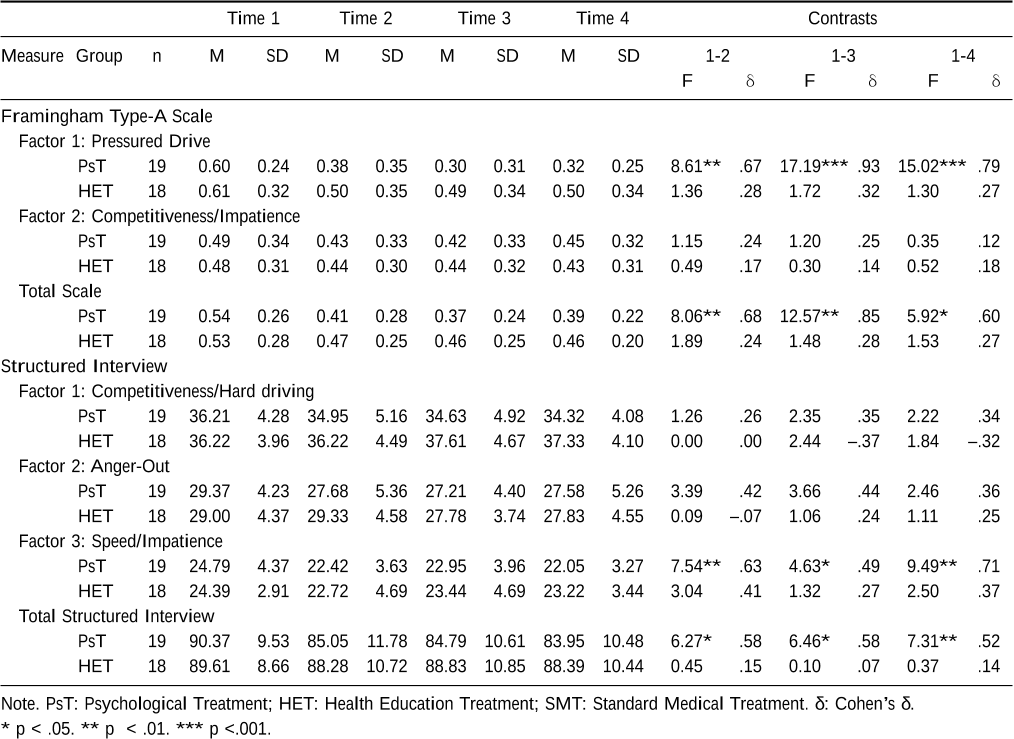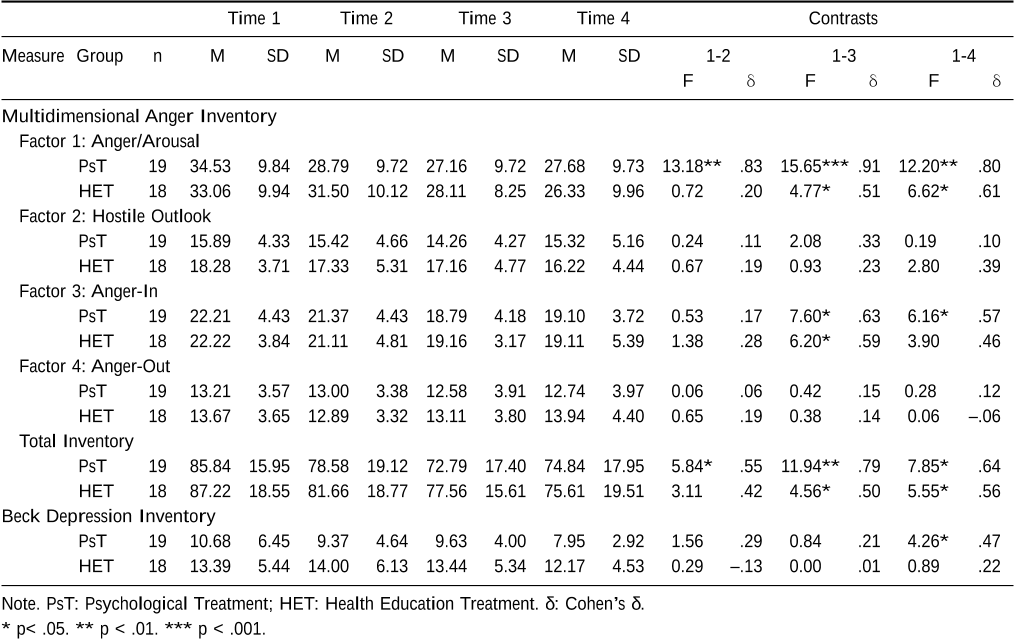The results of the psychological interventions carried out
until fifteen years ago for the type A behavior pattern and for
coronary heart disease were reflected in the meta-analysis of
Nunes, Frank, and Kornfeld (1987). The effect sizes of the
Type-A behavior pattern (TABP) change ranged from 0.02 to
1.27, with a mean of 0.61. No single treatment modality could
be considered efficacious, although the change of the TABP
effect size did correlate positively and significantly with the
number of treatment modalities used, and the combination of
an educational component, a coping method, either relaxation
or cognitive therapy, and a behavioral rehearsal achieved the
most significant TABP changes. Fernández-Abascal, Martín,
and Domínguez (2003) reviewed this issue in detail.
Linden, Stossel, and Maurice (1996) found in their meta-
analysis that the addition of psychosocial treatment to
standard cardiac rehabilitation regimes reduced psychological
distress during the first 2 years and that the patients who did
not receive psychosocial treatment had greater mortality and
cardiac recurrence rates during the first 2 years of follow-
up. The meta-analysis of Dusseldorp, van Elderen, Maes,
Meulman, and Kraaij (1999) examined the effects of
psychoeducational programs for coronary heart disease (CHD)
patients. The results suggest positive distal effects (34%
reduction in cardiac mortality, and 29% reduction in
recurrence of myocardial infarction) and significant positive
effects on proximal targets such as blood pressure, cholesterol,
and smoking behavior, but not on anxiety or depression.
The authors of these meta-analyses point out that these
programs should be adapted to the characteristics of different
groups of patients, especially groups of low socio-economic
status (Smith, Kendall, & Keefe, 2002), and the priority of
discovering the active components of the programs, so as to
reduce their duration and improve cost-benefit relationships.
The present study is an attempt to validate a treatment
program. While we acknowledge the influence, particularly
concerning procedure, of M. Friedman and co-workers from
the San Francisco Coronary/Cancer Prevention Project,
however, our theoretical perspective is closer to the
cognitive-behavioral orientation of Roskies (1987).
The aim of this study is to determine the effectiveness
of a cognitive-behavioral intervention trial to modify
coronary-prone behaviors, specifically the TABP components,
in people from a fairly low social and educational level who
have suffered from angina pectoris and/or myocardial
infarction. Using the treatment package strategy (Kazdin,
& Wilson, 1978), we began by elaborating a wide spectrum
cognitive-behavioral treatment package, so that in subsequent
research this treatment package could be dismantled.
Method
Sample and Selection Procedure
The sample was composed of males treated in the
University Hospital of the Canary Islands. The climate of
this region is mild and the life-style largely rural, the most
important economic activities involving service to the tourism
industry. The pace of life in the islands is, therefore, rather
slower than in more industrialized areas.
All the patients treated in the Cardiologist Service between
the years 1992-1995 were given information about secondary
prevention of CHD by a cardiologist and were invited to
participate in the project if they fulfilled the following three
conditions: (a) reliably documented evidence of CHD (in
most cases after catheterization), (b) no recommendation of
immediate surgical intervention, and (c) no medical or
psychological co-morbidity requiring individual intervention.
The project was developed in three stages or years. At
the beginning of each year, a meeting was organized with
the first 60 coronary patients who fulfilled the eligibility
requirements and had expressed interest in the project while
in hospital. At this meeting, the patients were given a short
explanation of the advantages of participating in a
Psychological Treatment (PsT) program or a Health
Education Treatment (HET) program to prevent reoccurrence
of coronary episodes. The need for participants in the control
group, who received only the University Hospital standard
medical treatment (SMT) program for coronary patients was
also explained, as was the calendar of the treatment programs
and the responsibilities acquired by the participants.
After this meeting, the research team allocated the
participants to the various groups. The first 40 volunteers
were allocated at random either to the PsT or the HET
groups, and the last 20 to volunteer, or those who would
have had difficulty in attending the treatment sessions at
that time, were assigned to the SMT control group. The
research design thus involved one experimental group, which
received the SMT and the PsT, and two control groups, one
that received both the SMT and the HET, and the other that
received only the SMT. This latter group was, in fact, a
waiting-list control group, as the members had the
opportunity to participate in the psychological or educational
treatment groups in subsequent years of the project.
At a second meeting, the patients who were still
interested in the program filled out a form with their personal
data and signed their free consent to participate and to
acknowledge their awareness of the commitment they
assumed as participants. In this session, the nurses and the
psychologists in charge of the treatments and a physician
acting for the University Hospital also signed the
responsibilities that each assumed. The participants also
filled in the psychological tests and questionnaires. After
this session, the psychologist in charge of the program had
an individual meeting with each participant to inform them
to which group they had been assigned.
In the first year of the project, both the PsT and HET
groups were randomly drawn and allocated, but the resulting
differences in education within the generally low educational
level of the groups made it difficult to carry out the treatment
programs and to achieve intragroup interaction.
MODIFICATION OF CORONARY-PRONE BEHAVIORS
69















